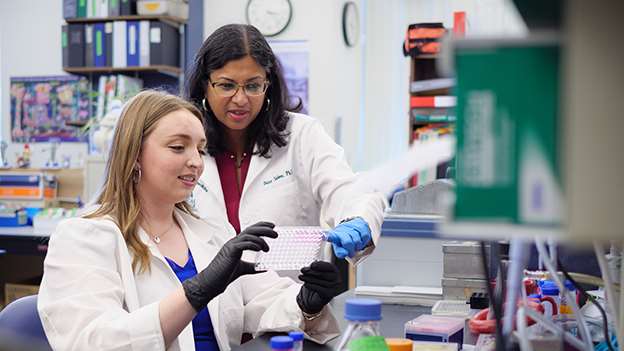Sahoo Laboratory
Location
Health Research Center
H4930
General Interests
Lipoprotein Metabolism, Scavenger Receptors, Cardiovascular Disease, Diabetes, Obesity

Research Areas
The role of scavenger receptors in cardiovascular disease and related metabolic disorders.
Atherosclerosis is a disease caused by plaque build-up in the artery wall, which ultimately results in reduced blood flow due to narrowing of the arteries. Plaque build-up results from the accumulation of cholesterol and other cellular debris. Cholesterol is carried through our bloodstream in vehicles called lipoproteins. Low density lipoproteins (LDL) – the “bad cholesterol” – carry cholesterol from the liver to peripheral tissues (such as the arterial wall). High density lipoproteins (HDL) – the “good cholesterol” – transport cholesterol from peripheral tissues back to the liver for excretion in a process called “reverse cholesterol transport.”
While HDL protects against atherosclerosis due to its role in reducing oxidative damage, preventing inflammation and promoting endothelial function, our lab is very interested in the role that HDL plays in reverse cholesterol transport and whole body cholesterol disposal.
Scavenger receptor class B type I (SR-BI), the most physiologically relevant HDL receptor, is highly expressed in the liver and plays a key role in mediating the delivery of HDL-C to the liver for excretion. Genetic mouse models demonstrate that SR-BI protects against atherosclerosis. Further, the recent discovery of SR-BI mutations in patients with high HDL-C levels strongly supports a critical role of SR-BI in facilitating the flux of cholesterol out of the body.
In order to develop novel therapeutic strategies that treat hypercholesterolemia and its associated pathologies such as atherosclerosis, it is critical that we understand the mechanisms that regulate receptor-ligand interactions at the end of reverse cholesterol transport. A better understanding of the interaction between SR-BI and HDL will allow us to gain novel insight into mechanisms that facilitate the efficient clearance of HDL-C via SR-BI-mediated selective uptake of HDL lipids.
Our laboratory is trying to answer the following questions:
- What are key structural features of SR-BI that facilitate HDL-cholesterol transport?
- Can we use biophysical and high-resolution techniques to gain structural information about full-length SR-BI and/or its extracellular/transmembrane domains?
- What is the oligomeric organization of SR-BI and how does that influence HDL-cholesterol transport?
- How does oxidation of HDL impact its cardio-protective functions and the progression of atherosclerosis?
- How does SR-BI facilitate cholesterol delivery into adipocytes?
- What happens when HDL-cholesterol gets hydrolyzed in cells?
- How does HDL impact beta cell function and diabetes?
Techniques
Research in the Sahoo laboratory relies on several techniques that will teach the following:
- Cell culture-based cholesterol transport assays
- Lipid and lipoprotein analyses
- Signal transduction
- Protein-protein interactions using biophysical/biochemical methods
- Fluorescence methodologies (e.g. spin labeling, FRET)
- Live cell imaging
- Confocal microscopy
- Mass Spectrometry (via collaboration)
- NMR (via collaboration)
- EPR (via collaboration)
- In vivo mouse models that express SR-BI mutants
- In vivo reverse cholesterol transport and atherosclerosis studies
Current Members




Scenes from the Sahoo Laboratory
Alumni/Former Trainees
- Gabriella Papale, PhD (2008-2012)
- Alexandra Chadwick, PhD (2010-2015)
- Rebecca Schill, PhD (2012-2018)
- Darcy Knaack
- Hayley Powers
Recent Publications
-
Gammaherpesvirus infection unveils exaggerated germinal center responses in an SR-BI-deficient host.
(Schmalzriedt DL, Johansen ER, Aurubin CA, Rahlf CR, Stuart B, Sahoo D, Tarakanova VL.) J Virol. 2025 Jul 22;99(7):e0075725 PMID: 40444948 PMCID: PMC12282102 SCOPUS ID: 2-s2.0-105011526722 05/30/2025
-
Apolipoprotein E selectively supports gammaherpesvirus replication in macrophages.
(Schmalzriedt DL, Aurubin CA, Rahlf CR, Brown MA, Bobek JM, Lange PT, Bradeen XG, Sahoo D, Tarakanova VL.) J Virol. 2025 Jun 17;99(6):e0048025 PMID: 40439406 PMCID: PMC12172433 SCOPUS ID: 2-s2.0-105008556948 05/29/2025
-
(Stuttgen GM, Ring CJ, Guda VS, Valdivia Esparza GK, Sahoo D.) J Biol Chem. 2025 May;301(5):108463 PMID: 40157537 PMCID: PMC12147181 SCOPUS ID: 2-s2.0-105003141604 03/30/2025
-
FFAR4 Deficiency Increases Necrotic Cores in Advanced Lesions of ApoE-/- Mice-Brief Report.
(Stuttgen GM, Bobek JM, Penoske R, Wadding-Lee C, Lam M, Hader SN, Owens AP 3rd, Sahoo D.) Arterioscler Thromb Vasc Biol. 2025 May;45(5):675-682 PMID: 40047073 PMCID: PMC12018153 SCOPUS ID: 2-s2.0-86000592687 03/06/2025
-
(Mestan KK, Sharma AM, Lazar S, Pandey S, Parast MM, Laurent LC, Prince LS, Sahoo D.) Pediatr Res. 2025 Apr 03 PMID: 40175585 PMCID: PMC12335971 04/03/2025
-
(Patro S, Choudhary A, Sharma V, Mahajan A, Sahoo D, Pattnaik SS.) Cureus. 2025 Feb;17(2):e79348 PMID: 40125168 PMCID: PMC11929124 03/24/2025
-
Sticky Business: Correlating Oligomeric Features of Class B Scavenger Receptors to Lipid Transport.
(Tillison EA, Sahoo D.) Curr Atheroscler Rep. 2024 Dec 04;27(1):15 PMID: 39630384 SCOPUS ID: 2-s2.0-85211368017 12/04/2024
-
A comprehensive analysis of the role of native and modified HDL in ER stress in primary macrophages.
(Bobek JM, Stuttgen GM, Sahoo D.) Front Cardiovasc Med. 2024;11:1448607 PMID: 39328237 PMCID: PMC11424405 09/27/2024
-
A comprehensive analysis of the role of native and modified HDL in ER stress in primary macrophages
(Bobek JM, Stuttgen GM, Sahoo D.) Frontiers in Cardiovascular Medicine. 2024;11 SCOPUS ID: 2-s2.0-85204912708 01/01/2024
-
Development and validation of a purification system for functional full-length human SR-B1 and CD36.
(Powers HR, Jenjak SE, Volkman BF, Sahoo D.) J Biol Chem. 2023 Oct;299(10):105187 PMID: 37625590 PMCID: PMC10509710 SCOPUS ID: 2-s2.0-85171377774 08/26/2023
-
Intracellular tPA-PAI-1 interaction determines VLDL assembly in hepatocytes.
(Dai W, Zhang H, Lund H, Zhang Z, Castleberry M, Rodriguez M, Kuriakose G, Gupta S, Lewandowska M, Powers HR, Valmiki S, Zhu J, Shapiro AD, Hussain MM, López JA, Sorci-Thomas MG, Silverstein RL, Ginsberg HN, Sahoo D, Tabas I, Zheng Z.) Science. 2023 Sep;381(6661):eadh5207 PMID: 37651538 PMCID: PMC10697821 SCOPUS ID: 2-s2.0-85169348601 08/31/2023
-
(Knaack DA, Chang J, Thomas MJ, Sorci-Thomas MG, Chen Y, Sahoo D.) bioRxiv. 2023 Aug 22 PMID: 37662321 PMCID: PMC10473602 09/04/2023





